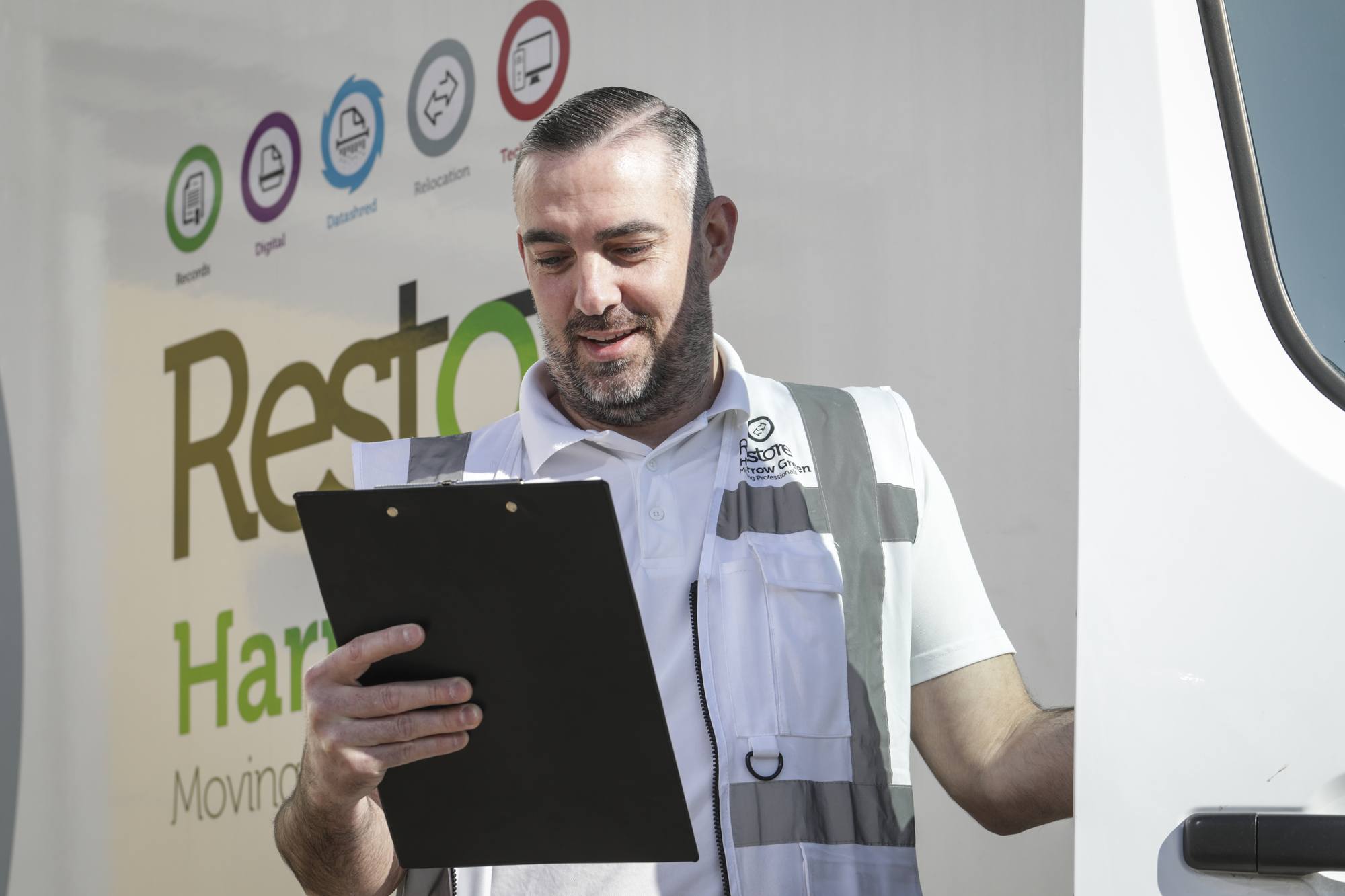
Relocating an office involves many moving parts, but one of the most critical priorities is a seamless transition for the IT infrastructure. Success depends on careful planning to prevent disruption, data loss and security gaps. This guide acts as a practical IT office relocation checklist so you can manage every stage of your office move with confidence.
If you’d like hands‑on help from specialists who do this every day, our teams deliver end‑to‑end office relocation services and business relocation services. For further reference, you can also download our whitepaper on planning an office move.
Before you start: scope your IT office relocation
Decide what “good” looks like for day one (such as no disruption of daily work, easy sign‑ins) and agree on a short pause on non-essential IT changes before the move
List what’s moving, what’s being refreshed, and what’s being retired (laptops, servers, printers and meeting‑room kit).
Note down the basics and what needs to work together: sign‑ins, networks, security tools and meeting‑room tech.
Plan for hybrid working with reliable remote access so people can work from home or the office on day one.
Coordinate early with the building team (landlord, security and lifts) and book early site access for surveys and pre‑staging.

Stage 1: Planning Phase (6–12 Months Before Move)

Build a small team that owns the move from start to finish. Put one person in charge of key decision-making and bring in the right people early – IT, team leads, and a trusted moving partner – so everyone knows what they are doing.
- Name one person to run the move; make roles and decisions clear.
- Involve IT, team leads and a proven moving partner.
- Hold short catch‑ups; track risks and pause non‑essential changes.

Make one clear list of all your kit, systems, logins and contracts to anchor your relocation decisions. Decide what you will keep, replace or recycle, and note any renewal dates. This helps you plan the move with no surprises when you switch over.
- List every device and system, plus logins and subscriptions.
- Mark what to keep, replace or recycle; note contract dates.
- Note which apps rely on which systems so you can plan testing.

Turn your list into a simple project plan with dates and owners. Link tasks to key business moments, include time for buying and testing, and write down what will make you pause or roll back if things start to look risky.
- Set dates and assign owners for buying, installing, testing and go‑live.
- Write down risks, backup plans and a simple rollback.
- Use the plan to align messages, budget and supplier bookings.

Check the new office early so set‑up is smooth for your relocation. Make sure power, cabling, internet, cooling and basic security are in place, and arrange early access for measurements and small pre‑installs to make day one easier.
- Check that power, data points, and Wi‑Fi provide the ideal amount of coverage.
- Make sure the IT room has space, cooling and secure access.
- Confirm broadband options and book early access for checks.

Create a simple budget that covers what you will buy, install and change. Include internet and phones, software updates, any short period where old and new services both run, and safe disposal and transport. Add a small buffer to account for unexpected issues or costs.
- Price up cabling, network gear, power backup, door entry, AV and internet.
- Include new devices, license changes, phone number moves and packing.
- Add a buffer and tie each cost to a milestone.
Tip: Keep each budget line tied to a dependency (e.g., “APs installed before staff induction”) to align your spending with project timelines.
Stage 2: Preparation Phase (3–6 Months Before Move)

Protect your data before you move anything. Make full copies, test that you can get files back, and keep a safe, locked copy so you can recover quickly if something goes wrong.
- Take full backups and test that you can restore them.
- Store copies safely off‑site and encrypted.
- List who can start a recovery and how to do it.

Plan where desks, meeting rooms and racks sit, where the cables and sockets are, and how long backup power will last if there’s a cut.
- Map where desks, racks, meeting rooms and network points go.
- Check power and cooling; know how long the backup power lasts.
- Match seating and device plans with HR/Facilities.

Sort out internet and phones early and allow time for building sign‑offs. Keep old and new services running for a short overlap, test that everything works, and keep a simple backup plan in case something fails.
- Order internet lines and book activation dates.
- Keep old and new services running briefly to avoid gaps.
- Schedule phone number moves and keep a fallback plan.

IT office moves are a great opportunity to tidy up security. Update protections on your network and laptops, plan safe disposal of old kit with proof, and take extra care with any devices or drives that hold sensitive data.
- Update security on gateways and laptops; keep multi‑factor sign‑in on.
- Dispose of old kit securely with proof that it was handled properly.
- Run a simple security check to catch gaps.

Share a short guide for staff, tell customers and suppliers about any short service windows, and add extra on‑site help for the first week.
- Share a short staff guide with what’s changing and when.
- Update website, email footers and helpdesk details.
- Plan extra on‑site help for the first week.
Stage 3: Execution Phase (1–2 Weeks Before Move)

Do a small practice run that looks like the real thing. Time each step, check your backup plan works, and use what you learn to finetune the plan and decide how many people you need on the day.
- Build a small test area and make sure everything fits together seamlessly.
- Practice what to do if something fails and time each step.
- Tell staff about new logins, security steps and any downtime.

Make sure every bit of kit is easy to track and safe to move so that set‑up is quick during the move. Back up data, shut things down properly, use the right packing, and take photos of complicated rack setups.
- Label kit clearly so it gets to the right desk.
- Photograph rack setups and keep gear supervised in transit.
- Back up data, shut down properly and use proper packing.

Switch on the most important pieces first, then add the rest. Start with the network, Wi‑Fi, sign‑in and storage, then set up devices and meeting rooms, and keep door access and cameras working throughout.
- Bring up the network, Wi‑Fi, sign‑in and storage first.
- Test the key software before everyone arrives.
- Keep door access and cameras running throughout.
Stage 4: Moving Day

Follow the IT office move checklist step by step and make sure the basics are ready before you turn things on. Ask key suppliers to be on‑site to fix issues quickly, and write down anything that has changed so you can sort it later.
- Set up equipment as planned and check power and internet.
- Have the internet/phone providers on site to fix issues fast.
- Note any changes so you can follow up later.

Test everything properly before you say the IT office relocation is done. Check the network, sign‑ins, phones and meeting tools work in the office and from home, and note any issues so they can be fixed as quickly as possible.
- Check that internet speed, sign‑in, printing and phones work.
- Test video calls and key business apps on wired and Wi‑Fi.
- Make sure remote access works and fix issues quickly.

Keep a close eye on security while the settings are newly calibrated. Make sure the rules are in place, two‑step sign‑in works, and someone is watching the logs to spot anything unusual early.
- Confirm security settings are active and up to date.
- Check that multi‑factor sign‑in works in and out of the office.
- Watch activity logs closely during and after the move.
Stage 5: Post-Move Optimisation (1–3 Months After Move)

After the IT office move, listen to what the systems and your people are telling you. Use the data and feedback to fix setup mistakes and smooth out things like patchy Wi‑Fi or devices that weren’t set up quite right.
- Use monitoring and staff feedback to fix rough edges.
- Tidy up noisy Wi‑Fi and any devices set up incorrectly.
- Turn quick fixes into small tasks and longer projects.

Update your records and how‑to guides so support is simple and consistent after the relocation. Refresh maps and recovery steps, tidy your kit and licence lists, and show teams what has changed and how to use it.
- Update network maps, recovery guides and asset lists.
- Refresh how‑to guides for printing, meeting rooms and security.
- Show teams what’s new and how to use it.

Check how well you can bounce back if something goes wrong in the new space. Use what you learned during the move to improve your backup, failover and emergency steps.
- Recheck backups, targets and failover routes.
- Run short drills and update the emergency steps.
- Fold lessons learned into your continuity plan.

Keep things healthy with regular care after the move and use the fresh start to clear old problems. Plan steady updates, health checks and upgrades that fit your goals and suit the new office.
- Set regular patching, health checks and tuning.
- Remove or combine old servers; move suitable systems to the cloud.
- Review suppliers and renewals based on the new setup.
Optional Add-Ons

Choose a point person for the move, run quick info sessions before moving day, and send a short weekly update – simple touches that help everyone feel informed and supported.

Moves are perfect for right-sizing storage. Decide what to move, archive, digitise or securely destroy; keep disposal and chain‑of‑custody records for compliance purposes.

Check health and safety paperwork and ensure that they can handle IT moves. Run a short pre‑move workshop to spot and reduce risks.

Arrange early access so you can measure the space, plan the layout, and fit simple items (like cabling) when other parties are involved.

Pulling It All Together
A well‑planned IT office move is a coordinated project across people, processes, and platforms. Follow the staged IT office move checklist above, and use the changeover to make measured improvements to performance and security, not just to “lift and shift.”
Prefer to hand this over? We deliver IT audits, packing and labelling, secure transport, deployment, hypercare, and post-move optimisation-scaled to your timeline and budget. Get a quote and we’ll build your IT office move plan with you.
Contact Us Customer Login
Customer Login